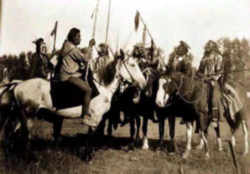


Mississippi Symbols
Mississippi Early History
First Early Inhabitants of Mississippi

Early history examines the archaeological record that tells the story of the first inhabitants of Mississippi. Learn about the prehistory and culture of the first early inhabitants, and what lessons it might teach us about the early history of Mississippi.
Mississippi First Early Inhabitants Timeline
- 55.8Mil BC - In 2008 scientists reported that a small primate species, named Teilhardina magnoliana lived about this time and inhabited what later became east-central Mississippi. (SFC, 3/4/08, p.A15)
- 12,000 years ago - A river is born. As glaciers from last Ice Age recede, flood waters carve channel of Mississippi.
- 10,000BCE-1518CE Early Civilizations: The First Peoples
- 10,000 to 9,000 years ago - First evidence of human habitation in Upper Mississippi region.
- ca. 10,000 BC - 8,000 BC Paleo-Indian culture When humans first inhabited the area known today as Mississippi, much of the water of North America was in glacial form. The Gulf of Mexico's coastline was far south of today's coast, and the Mississippi River was a series of interwoven, braided streams. Within these braided stream areas were small prairies. The climate here was much colder, similar to that of Southern Canada today and forests of spruce and fir covered much of the land. This was the Pleistocene Era, also known as the Ice Age.
- ca. 8,000 BC to 500 BC The Archaic With a warming of the climate over time, people gradually made a transition from semi-nomadic to a more sedentary life. Instead of frequently migrating, people settled for longer periods of time based on seasonal and geographic variation in foods and other resources (Hudson, 1976). The areas that they would have roamed as part of their seasonal rounds would have become smaller as they became more familiar with local food sources and as the warming climate allowed different species, such as white-tailed deer, to thrive. Large mammals disappeared, and hunting of smaller species, including deer, became the focus.
- 8,000 years ago - Hunters slaughter giant bison in what is now Itasca State Park, leaving evidence of their presence.
- 2,000 years ago - Hopewell (Mound building) culture dominates area. Burial mounds left at many sites along river, including what is now Mounds Park in St. Paul.
- ca. 500 BC to 1000 AD The Woodland Stage Many of the same trends that began in the Late Archaic continued and flourished in the Woodland Period as people began to use their resources more efficiently. The technology of pottery-making spread and its usefulness as storage containers and cooking vessels combined with further plant domestication of starchy seed-bearing plants (not yet corn), led to a more sedentary existence. Hunting, fishing, and gathering continued to be important as sources of food and other necessities as villages began to evolve from previous bands of people (Anderson and Mainfort 2002).
- 1000 - Mississippian Culture established. This was the last of the mound-building cultures of North America in Midwestern, Eastern, and Southeastern United States
- 1540 - Hernando de Soto (1500-1542) explores Mississippi
- 1643 - Rene-Robert Cavelier, Sieur de La Salle (1643-1687) navigates the Mississippi River and claims Mississippi for France
- 1700's - French fur trading era begins
1729 - Following the Natchez Wars of 1716, 1722 and 1723 the Natchez Rebellion (1729-1731) when Natchez Indians massacre 250 people at Fort Rosalie.
Early History of Native Americans in Mississippi
The Indigenous People of Mississippi
The names of the Mississippi tribes included the Biloxi, Capinans, Chakchiuma, Chickasaw, Choctaw, Choula, Dakota Sioux, Grigra, Houma, Ibitoupa, Koroa, Moctobi, Natchez, Ofo, Okelousa, Pascagoula, Pensacola, Quapaw, Taposa, Tiou, Tunica and Yazoo.
Before Europeans began to explore the area now known as Mississippi, three major Native American groups lived there. In the north and the eastern parts of the state were the Chickasaw. The Choctaw lived in the central part of territory and the Natchez lived in the southwest.
The Chickasaw were formidable warriors who lived in villages along streams and rivers. Men and women wore clothes made of buckskin in the summer and added buffalo robes in colder weather. Both men and women had long hair. The ultimate badge of honor for a Chickasaw warrior was a mantle, or robe, made out of swan feathers.
Groups of Chickasaw were generally independent of one another politically, but would organize together in times of war. Beginning during the American Revolution, Chickasaw lands in the Mississippi River area were confiscated because the Chickasaw supported the British. Eventually, because of the Indian Removal Act in 1830, the Chickasaw were re-settled in southeast Oklahoma on land that belonged to their former neighbors, the Choctaw.
The Choctaw people's legends say they originated from "Nanih Waya" (which means Protective Mound), a sacred hill near what is now Noxapter, Mississippi. Similar to the Chickasaw, the Choctaw were actually a loose confederation of clans or groups, each with its own village chief. Before they were relocated to Oklahoma, however, the Choctaw had developed their first Constitution, which served as a governing document for the entire tribe.





